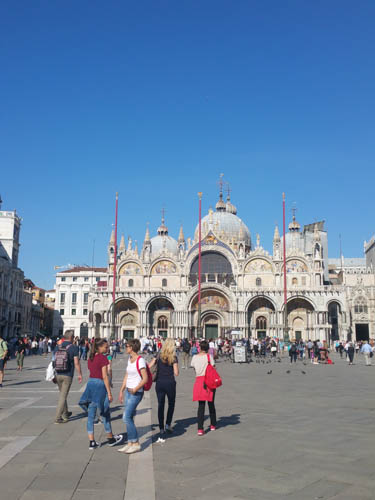St. Mark’s Basilica, nestled in the heart of Venice at the Piazza San Marco, is a testament to the city’s rich religious and political history. This cathedral, dedicated to Saint Mark the Evangelist, captivates visitors with its intricate mosaics and gleaming gold decorations, embodying the splendor of Byzantine art. With its roots in churches dating from the 9th century, the present-day structure of Basilica di San Marco has been the centerpiece of religious life in Venice since 1063. Millions come from around the world to explore its history and marvel at its art and architecture.
Since throngs of travelers are eager to visit this Venetian treasure (it seems like millions are there at one time if you’ve ever seen the lines), reserving St. Mark’s Basilica tickets or opting for a “skip the line” tour can enhance the visiting experience. I’ve provided contact information for Roaming Historian’s affiliates, so you can visit Basilica di San Marco, St. Mark’s Square, and the rest of Venice like a VIP.
Historical Background of St. Mark’s Basilica
St. Mark’s Basilica is a crowning jewel in the heart of Venice. Constructed between 1063 and 1094, the basilica was inspired by the Church of the Holy Apostles in Constantinople, reflecting a rich Byzantine influence that characterizes its style.
Initial Construction: Begun in 1063 under Domenico Contarini’s patronage, the structure was designed to enshrine Saint Mark’s relics (reportedly smuggled from Alexandria in a barrel of pork), establishing a spiritual and political emblem of Venetian power.
Artistic and Structural Enhancements: Over the years, the basilica underwent numerous renovations, incorporating Romanesque and Gothic elements alongside its predominant Byzantine style. This blend is evident in the intricate designs that adorn the west façade and the vibrant mosaics that cover the interior.
Mosaics and Artworks: The interior domes and vaults boast gold-ground mosaics depicting saints, prophets, and biblical scenes, showcasing eight centuries of evolving artistic styles. Notable among the treasures are the Pala d’Oro, an exquisite altarpiece from the 10th century, and the Treasury, which contains a vast collection of artifacts from various epochs.
Exterior Marvels: The basilica’s façade features elaborate marble inlays and sculptures that tell tales of Venetian affluence and influence, further emphasized by approximately 500 ancient columns that…
Click Here to Read the Full Original Article at Roaming Historian…
